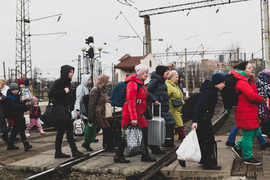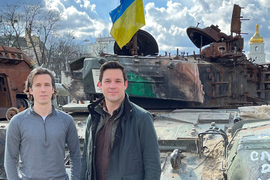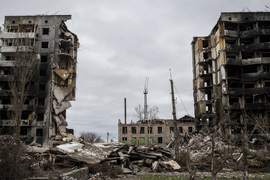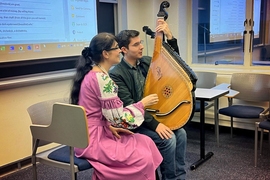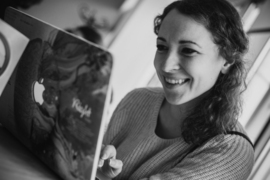Russia’s ongoing full-scale invasion of Ukraine, commencing in February 2022, is continuing to cause immense upheaval and destruction, and Ukrainians continue to fight to defend their nation-state. Last fall, MIT launched its MIT-Ukraine program, an effort to find ways to leverage the Institute’s expertise and resources to help a country devastated by war. This has meant confronting new challenges. MIT-Ukraine is part of MISTI, the MIT International Science and Technology Initiatives, an international education program that usually sends students abroad on internships with host companies. But that is not feasible in Ukraine while the country is enveloped in war. Instead, the MIT-Ukraine program is implementing other types of projects to help Ukrainians, including working with those who have been displaced by the invasion, inside and outside the country.
To learn more, MIT News talked to Elizabeth Wood, professor of history at MIT, co-director of the MIT-Eurasia program within MISTI, and head of the MIT-Ukraine program, and to Svitlana Krasynska, program manager of MIT-Ukraine. We also solicited input from others involved in the program, including Andrii Zahorodnii and Dima Yanovsky, MIT undergraduates from Ukraine; Yevheniia Polishchuk, director of the Scholar Support Office in Ukraine and a professor at Kyiv National Economic University; and Svetlana Boriskina, a principal research scientist in MIT’s Department of Mechanical Engineering. This is an account of the program’s origins and goals.
Wood: At its core, the MIT-Ukraine program differs from the traditional MISTI program, which is designed to help students gain an appreciation of a different culture by working in it. In this case, we can’t send students to Ukraine. But we are trying to engage MIT faculty and students so that the students are working to meet the needs of the Ukrainian people. We are doing something that is aligned with purpose: solving real problems of a real society that’s in real crisis.
We have tremendous student interest and very good faculty interest. I had a student write me and say “Dear Professor Wood, I’d like to work on refugees in Ukraine.” I wrote back immediately to him. The next day we got an email from his father, who is an MIT alum, saying, “This is what I love about MIT, a professor responds to a student right away.” The gentlemen also said, “I have small family foundation. It may not seem like much, but we could give you $75,000 to support the MIT-Ukraine program.” Having a gift like that is really critical. With one email, we got a grant that sets up the finances we need to start.
Krasynska: There are three directions that we pursue in this program. One is to use existing coursework and labwork across the MIT campus to direct work toward Ukraine-focused projects. For example, there is a digital humanities course where we have six UROP students designing a platform for Ukrainian scholars all over the world. This is a project spearheaded by Ukraine’s Scholar Support Office at the Ministry of Education, which is trying to give the displaced scholars one place [online] where they can go to for support, collaboration, and information about professional opportunities. The MIT students are building this platform, including an interactive map of scientists’ locations and areas of expertise.
Another example is the water and sanitation course Susan Murcott is teaching, where a group of students is working on designing innovative and carbon-neutral water distribution systems. The students are researching the existing issues with water distribution in Ukraine. Not only have many buildings and much critical infrastructure been bombed and destroyed, but Ukraine also has outdated and overly centralized Soviet-built water distribution systems that are vulnerable to outages and attacks. So, the students are working with Ukrainian water experts to develop a new set of ideas on how to distribute water more efficiently.
The second program direction is focused on supporting Ukrainian scientists, both in Ukraine and in other countries. Many scientists have lost their labs in the war due to the shelling of university buildings and the destruction of critical infrastructure. Thousands of scientists have also lost funding and home institutions. We are trying to see how we can support some of these scientists by facilitating their collaboration with MIT researchers.
Finally, because this is a MISTI program, we have to think creatively about what meaningful and engaging internships might look like. First, we are developing opportunities for MIT students to work with Ukrainian organizations and companies virtually. Second, we are looking into creating internships that are Ukraine-focused but based in other countries, mainly in Europe, where there are significant Ukrainian refugee populations. We are currently working on placing students virtually, as well as in-person, in different countries, such as Spain, Finland, Switzerland, and Poland, for this upcoming summer.
So, those are our three key program directions: Using existing coursework and lab work, supporting science and research, and creating virtual and third-country internships.
Wood: It’s been really exciting working directly with the six students on the scholarship support project. They want to keep scientists connected to Ukraine so that brain drain doesn’t destroy the country once the war is over. If so many people flee and just settle in Warsaw or Krakow, then the country has lost, too.
Yevheniia Polishchuk is the lead within Ukraine’s Scholar Support Office on the project to build the database for displaced scientists.
Polishchuk: Colleagues and students from MIT are lending their support to the Scholar Support Office in Ukraine, collaborating to create a cutting-edge digital platform aimed at serving the Ukrainian science diaspora. This initiative came in response to the large number of scientists who were forced to flee Ukraine due to the Russian invasion. It is estimated that over 5,000 Ukrainian scholars were affected by this crisis, and many of them are eager to connect with their professional community and contribute to the postwar rebuilding of their homeland.
The platform will function as a hub for Ukrainian scholars, uniting individuals from different waves of migration and facilitating communication and collaboration on future projects. One of the key features of the platform will be a world map that highlights the locations of Ukrainian scientists, making it easier to find and connect with fellow professionals.
The teams from both organizations are meeting regularly to discuss the vision and characteristics of the platform. From the Scholar Support Office, Dr. Igor Lyman and I are providing critical input, while Professor Wood, Dr. Krasynska, and students from MIT are offering ideas on how the platform can be optimized to best serve the needs of the Ukrainian science diaspora.
The platform was presented at the Second Conference on the Ukraine Crisis, exploring the impact on the science sector and supporting initiatives, hosted by the International Science Council and ALLEA (All European Academies) in March, where participants shared feedback and expressed enthusiasm. Users are eagerly awaiting the official launch of the platform, which will be accompanied by training for administrators. This collaborative effort is a crucial step toward preserving the the human capital of Ukraine, an essential resource for the nation's future development.
Meanwhile, Svetlana Boriskina, a principal research scientist in MIT’s Department of Mechanical Engineering, is working with Ukrainian researchers to bolster their own research opportunities.
Boriskina: The Russian invasion of Ukraine was both long-expected and still unbelievable for me personally when it happened. The lives of people in my hometown Kharkiv — including my family — have been changed drastically, due to its close proximity to the Ukraine-Russia border. Kharkiv is also a major academic and research center of Ukraine, a home of many universities and research facilities whose operation has been disrupted or completely halted by the invasion. Employees of these institutions worked heroically to protect the equipment and personnel, to limit the damage done by Russian bombs, and to create the conditions for rebuilding after the war.
For the past year, I have [wanted] to help the Ukrainian research community survive, and to provide postwar educational and work opportunities for students and researchers who found refuge in the West, so they would choose to return and rebuild. First, it was important to spread the awareness of the great potential of Ukrainian academia and national research facilities, to make U.S. and EU researchers interested in pursuing collaborations. I hope my article “Optics in Ukraine,” published in Optics and Photonics News last year helped this goal.
Over the IAP period this winter, I worked with three great UROP students — Tatiana Vassiliev and Michael Kubera from MIT, and Juliana Mytko from Wellesley College — on building the science communication infrastructure to help connect MIT PIs and Ukrainian researchers around potential joint research projects. We recruited several MIT faculty members as proposal reviewers for the National Research Foundation of Ukraine, and have also been working on establishing contacts with institutions hosting Ukrainian students and researchers fleeing the war. These include the Institute of Physics of the Polish Academy of Sciences, the Nuclear Physics Institute of the Czech Academy of Sciences, and Tel Aviv University in Israel. We plan research collaboration and student exchanges with these institutions, as well as helping Ukrainian research groups in Kharkiv to visit MIT. We are looking for additional fundraising opportunities to support these collaborations.
I firmly believe that with the help of the international community, Ukrainian science can once again succeed. But it does need our help, and MIT can and should play a leading role in this effort.
Other MIT-Ukraine projects are aimed at giving school-age students additional academic opportunities. Andrii Zahorodnii, a junior in brain and cognitive sciences, and Dima Yanovsky, a senior in electrical engineering and computer science, launched their own MIT-Ukraine project, to work with advanced computer science students from Ukraine at an instructional camp in Europe this summer.
Zahorodnii: Dima and I are developing an innovative educational program for Ukraine’s most talented high schoolers, through a new partnership with MIT.
Back in Ukraine, there are brilliant kids that have the potential to become the next leaders and ensure that the future is bright for all of us. These young people are growing up during a time of war and hardship, but they possess a unique perspective that will be invaluable as the country moves forward. However, right now what they so desperately need is an opportunity to reach their potential.
We want to equip Ukrainian kids with the skills, knowledge, and confidence they need to rebuild Ukraine into a thriving, European nation. A nation that will prove to the world that it is never time to give up. That is our vision.
Yanovsky: Andrii was at MIT a year prior to me. When I visited campus right after being accepted, Andrii hosted me in Cambridge for a few days. So, naturally, all we talked about was how to help Ukraine. More specifically, trying to help kids of our generation. This was when the idea of the educational program was born.
Zahorodnii: I’m extremely grateful for the opportunity I was given to study here, at MIT. Now that I am here, and especially during this hard time, I feel an overwhelming urge to do everything I can for the community that brought me up. When Dima came to MIT and shared my enthusiasm, we decided to get serious with our ideas.
Some MIT faculty had already been studying Ukraine before the invasion. Brent D. Ryan, an associate provost at MIT and associate professor of urban design and public policy, had been researching Ukraine’s large industrial cities. Some of his former Fulbright scholars are supporting a project to refurbish abandoned dormitories in Ukraine to create housing for internally displaced persons who have been forced to move within the country.
Krasynska: Last year Professor Brent Ryan hosted two Ukrainian fellows who were at MIT on Fulbright scholarships. These fellows have been involved with a fairly large nonprofit organization in Ukraine that identifies abandoned or underutilized buildings and then uses sustainable materials to refurbish them for the internally displaced families. The project, called Co-Haty, prides itself on involving local communities where these building projects are located, as well as the people who will be living in these refurbished buildings, in the reconstruction process. This helps foster a sense of community and ownership in the project for those benefiting from it. Two MIT graduate architecture students will be working with the Co-Haty project as full-time interns this coming summer. The internships will be partly remote, with students working virtually for part of the time and partly in person with travel to Zurich, where some of the Ukrainian partners are located. Among other things, they will work to to source the materials strategically, design the buildings, and develop many other aspects of this important program.
Wood: The Co-Haty program is thus doubly symbolic. It’s both repurposing material, so that’s environmentally sound, but it’s also moving away from the Soviet past and making Ukraine a fully modern, European country, which is so important to the Ukrainians right now.
Ultimately, Krasynska and Wood say, they hope faculty and students can continue developing scalable projects, with the assistance of MIT-Ukraine.
Krasynska: The situation is enormously overwhelming, when I think about the scale of destruction. But what I’ve learned is that we all contribute little things. When I was bringing in supplies [to Ukraine], I would deliver four suitcases of tourniquets and bandages, and think, “This is nothing.” But there are millions of people who can bring four suitcases of supplies, and if each can even save one life, that is worth everything. So, we need to think about how these projects add up. We might refurbish one building at first, and house three families, but if we put together a team, we can build a lot of homes and place a lot of families. It’s important to understand the collective nature of these small projects. That’s how you win the battle, each person adds their piece.
Wood: There are faculty who are working on projects, there are students working on projects, and the MIT-Ukraine program is trying to be a hub and a clearinghouse to help, without dominating anyone’s projects but letting things grow.
